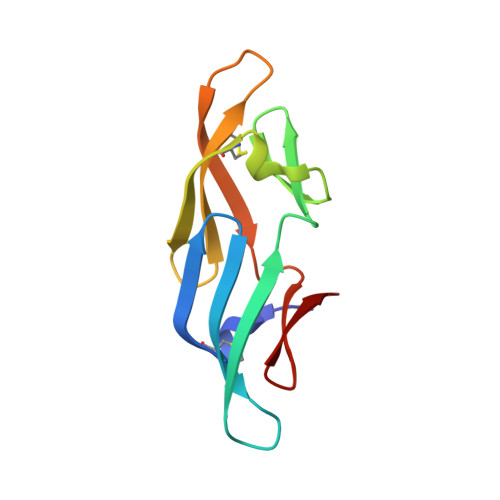Solution Structure of a Cyanovirin-N:Man alpha 1-2Man alpha Complex. Structural Basis for High Affinity Carbohydrate-Mediated Binding to gp120
Bewley, C.A.(2001) Structure 9: 931-940
- PubMed: 11591348
- DOI: https://doi.org/10.1016/s0969-2126(01)00653-0
- Primary Citation of Related Structures:
1IIY - PubMed Abstract:
Cyanovirin-N (CVN) is a novel, 11 kDa cyanobacterial protein that potently inhibits viral entry by diverse strains of HIV through high-affinity carbohydrate-mediated interactions with the viral envelope glycoprotein gp120. CVN contains two symmetry-related carbohydrate binding sites of differing affinities that selectively bind to Man(8) D1D3 and Man(9) with nanomolar affinities, the carbohydrates that also mediate CVN:gp120 binding. High-resolution structural studies of CVN in complex with a representative oligosaccharide are desirable for understanding the structural basis for this unprecedented specificity. We have determined by multidimensional heteronuclear NMR spectroscopy the three-dimensional solution structure of CVN in complex with two equivalents of the disaccharide Manalpha1-2Manalpha, a high-affinity ligand which represents the terminal-accessible disaccharide present in Man(8) D1D3 and Man(9). The structure reveals that the bound disaccharide adopts the stacked conformation, thereby explaining the selectivity for Man(8) D1D3 and Man(9) over other oligomannose structures, and presents two novel carbohydrate binding sites that account for the differing affinities of the two sites. The high-affinity site comprises a deep pocket that nearly envelops the disaccharide, while the lower-affinity site comprises a semicircular cleft that partially surrounds the disaccharide. The approximately 40 A spacing of the two binding sites provides a simple model for CVN:gp120 binding. The CVN:Manalpha1-2Manalpha complex provides the first high-resolution structure of a mannose-specific protein-carbohydrate complex with nanomolar affinity and presents a new carbohydrate binding motif, as well as a new class of carbohydrate binding protein, that facilitates divalent binding via a monomeric protein.
Organizational Affiliation:
Laboratory of Bioorganic Chemistry, National Institute of Diabetes and Digestive and Kidney Diseases, National Institutes of Health, Bethesda, MD 20892, USA. caroleb@intra.niddk.nih.gov
















